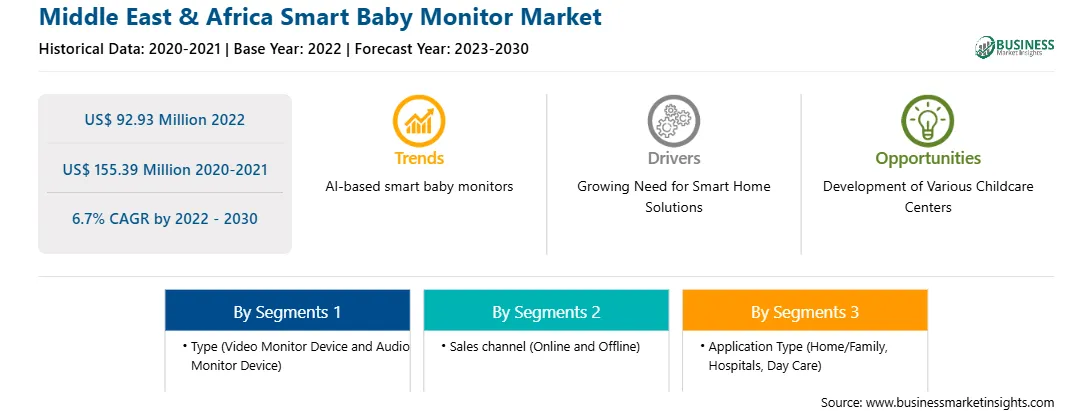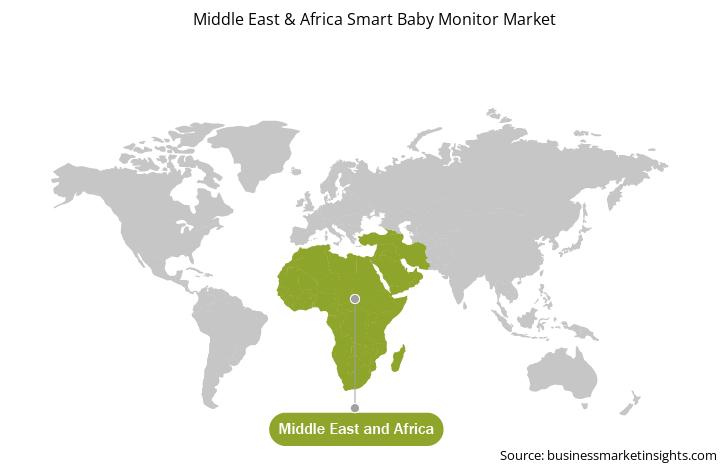The Middle East & Africa smart baby monitor market was valued at US$ 92.93 million in 2022 and is expected to reach US$ 155.39 million by 2030; it is estimated to grow at a CAGR of 6.7% from 2022 to 2030.
The smart baby monitoring device manufacturers are investing in the integration of artificial intelligence (AI) technology with their offerings. The integration of AI confers various intelligent features to the systems, such as baby cry detection, humidity and temperature measurements, and smart alerts, along with advanced speaker and microphone competencies for recording, singing, or storytelling; it also allows the replay of the recordings with high quality. It alerts parents through a wake-up light and night light that help them change diapers without startling the baby during the night. For instance, KamiBaby integrates edge computing technology with its baby monitors, which record the moments and share them with people who have access to the system. The integration of such advanced technologies with smart home devices allows parents to monitor their baby on devices run by Google Assistant and Amazon Alexa that are equipped with displays. Other features of KamiBaby devices include sleep summary of baby, live stream video sharing, two-way talk, 360-degree high-quality speakers, temperature and humidity sensors, built-in night light, kami cloud and SD card storage, and FHD 1080P premium image quality. In addition, in January 2023, Chillax, manufacturers of the first baby monitor that uses edge computing-based AI and machine learning techniques to precisely detect a covered face, roll-over, and breathing rate, introduced its latest solutions at the Consumer Electronics Show (CES) 2023. The company also introduced all-new Giraffe AI, Thermo AI, and Care Plus models.
Thus, the development of AI-based smart baby monitors is emerging as a key trend in the market and is expected to gain traction in the coming years.
The MEA includes South Africa, Saudi Arabia, the UAE, and the Rest of MEA. The region is projected to witness a rapid rise in industrialization, which would further drive the growth of its currently average economy. The Gulf countries are economically advanced, while the African countries are yet to match their economic conditions. Rise in per capita income, recovery of economic conditions, and increase in government spending on the development of day care/childcare centers are among the factors anticipated to boost the adoption of smart baby monitors across the Gulf countries.
The rising number of women working and stepping out of their houses is one of the key factors likely to contribute to the smart baby monitor market growth in the MEA. As per UNICEF, the organization encouraging the children's well-being and enhance children's lives by protecting them. This initiative makes the organizations treat their employees, develop, and market their products, operate facilities, provide services, and influence economic and social development. This factor has led to the launch of day care and child care centers in the region. These conditions boost the demand for the installation of smart baby monitors at the day care or childcare facilities built for the children of employees. Furthermore, the increasing number of tech-savvy parents is leading to a rise in adoption of smart baby monitor in the MEA.
Strategic insights for the Middle East & Africa Smart Baby Monitor provides data-driven analysis of the industry landscape, including current trends, key players, and regional nuances. These insights offer actionable recommendations, enabling readers to differentiate themselves from competitors by identifying untapped segments or developing unique value propositions. Leveraging data analytics, these insights help industry players anticipate the market shifts, whether investors, manufacturers, or other stakeholders. A future-oriented perspective is essential, helping stakeholders anticipate market shifts and position themselves for long-term success in this dynamic region. Ultimately, effective strategic insights empower readers to make informed decisions that drive profitability and achieve their business objectives within the market.

| Report Attribute | Details |
|---|---|
| Market size in 2022 | US$ 92.93 Million |
| Market Size by 2030 | US$ 155.39 Million |
| Global CAGR (2022 - 2030) | 6.7% |
| Historical Data | 2020-2021 |
| Forecast period | 2023-2030 |
| Segments Covered |
By Type
|
| Regions and Countries Covered | Middle East and Africa
|
| Market leaders and key company profiles |
The geographic scope of the Middle East & Africa Smart Baby Monitor refers to the specific areas in which a business operates and competes. Understanding local distinctions, such as diverse consumer preferences (e.g., demand for specific plug types or battery backup durations), varying economic conditions, and regulatory environments, is crucial for tailoring strategies to specific markets. Businesses can expand their reach by identifying underserved areas or adapting their offerings to meet local demands. A clear market focus allows for more effective resource allocation, targeted marketing campaigns, and better positioning against local competitors, ultimately driving growth in those targeted areas.

The Middle East & Africa smart baby monitor market is segmented based on type, sales channel, application, and country.
Based on type, the Middle East & Africa smart baby monitor market is segmented into video monitor device and audio monitor device. The video monitor device segment held a larger market share in 2022.
Based on sales channel, the Middle East & Africa smart baby monitor market is bifurcated into online and offline. The offline held a larger market share in 2022.
Based on application, the Middle East & Africa smart baby monitor market is segmented into home/family, hospitals, and day care. The home/family held the largest market share in 2022.
Based on country, the Middle East & Africa smart baby monitor market is segmented into South Africa, Saudi Arabia, the UAE, and the Rest of Middle East & Africa. The UAE dominated the Middle East & Africa smart baby monitor market share in 2022.
Vtech Holdings Ltd, Koninklijke Philips NV, Samsung Electronics Co Ltd, Panasonic Holdings Corp, Snuza, and NETGEAR are some of the leading companies operating in the Middle East & Africa smart baby monitor market.
1. VTech Holdings Ltd
2. Koninklijke Philips NV
3. Samsung Electronics Co Ltd
4. Panasonic Holdings Corp
5. Snuza
6. NETGEAR.
The Middle East & Africa Smart Baby Monitor Market is valued at US$ 92.93 Million in 2022, it is projected to reach US$ 155.39 Million by 2030.
As per our report Middle East & Africa Smart Baby Monitor Market, the market size is valued at US$ 92.93 Million in 2022, projecting it to reach US$ 155.39 Million by 2030. This translates to a CAGR of approximately 6.7% during the forecast period.
The Middle East & Africa Smart Baby Monitor Market report typically cover these key segments-
The historic period, base year, and forecast period can vary slightly depending on the specific market research report. However, for the Middle East & Africa Smart Baby Monitor Market report:
The Middle East & Africa Smart Baby Monitor Market is populated by several key players, each contributing to its growth and innovation. Some of the major players include:
The Middle East & Africa Smart Baby Monitor Market report is valuable for diverse stakeholders, including:
Essentially, anyone involved in or considering involvement in the Middle East & Africa Smart Baby Monitor Market value chain can benefit from the information contained in a comprehensive market report.